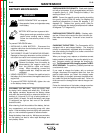
BATTERY MAINTENANCE
GASES FROM BATTERY can explode.
• Keep sparks, flame, and cigarettes away
from battery.
BATTERY ACID can burn eyes and skin.
• Wear gloves and eye protection and be
careful when working near a battery.
Follow the instructions printed on the
battery.
To prevent EXPLOSION when:
• INSTALLING A NEW BATTERY - Disconnect the
negative cable from the old battery first and connect
to the new battery last.
•
THE CORRECT POLARITY IS NEGATIVE GROUND
-
Damage to the engine alternator and the printed cir-
cuit board can result from incorrect connection.
• CONNECTING A BATTERY CHARGER -
Remove the battery from the welder by
disconnecting the negative cable first,
then the positive cable and battery
clamp. When reinstalling, connect the
negative cable last. Keep the area well
ventilated.
• USING A BOOSTER - Connect the positive lead to
the battery first, then connect the negative lead to the
engine foot.
• To prevent BATTERY BUCKLING, tighten the nuts
on the battery clamp until snug.
CLEANING THE BATTERY: Keep the battery clean
by wiping it with a damp cloth when dirty. If the termi-
nals appear corroded, disconnect the battery cables
and wash the terminals with an ammonia solution or a
solution of 1/4 pound (0.113 kg) of baking soda and 1
quart (0.946 l) of water. Be sure the battery vent plugs
(if equipped) are tight so that none of the solution
enters the cells.
After cleaning, flush the outside of the battery, the bat-
tery compartment, and surrounding areas with clear
water. Coat the battery terminals lightly with petroleum
jelly or a non-conductive grease to retard corrosion.
Keep the battery clean and dry. Moisture accumulation
on the battery can lead to more rapid discharge and
early battery failure.
CHECKING SPECIFIC GRAVITY: Check each battery
cell with a hydrometer. A fully charged battery will have
a specific gravity of 1.260. Charge the battery if the
reading is below 1.215.
NOTE: Correct the specific gravity reading by adding
four gravity points (0.004) for every five degrees the
electrolyte temperature is above 80 degrees F (27
degrees (C). Subtract four gravity points (.004) for
every five degrees the electrolyte temperature is below
80 degrees F (27 degrees C).
CHECKING ELECTROLYTE LEVEL: If battery cells
are low, fill them to the neck of the filler hole with dis-
tilled water and recharge. If one cell is low, check for
leaks.
CHARGING THE BATTERY: The Commander 400 is
equipped with a wet charged battery. The charging
current is automatically regulated when the battery is
low (after starting the engine) to a trickle current when
the battery is fully charged.
When you charge, jump, replace, or otherwise connect
battery cables to the battery, be sure the polarity is cor-
rect. Improper polarity can damage the charging cir-
cuit. The Commander 400 charging system is NEG-
ATIVE GROUND. The positive (+) battery terminal has
a red terminal cover.
If you need to charge the battery with an external
charger, disconnect the negative cable first, then the
positive cable before you attach the charger leads.
After the battery is charged, reconnect the positive bat-
tery cable first and the negative cable last. Failure to
do so can result in damage to the internal charger com-
ponents.
Follow the instructions of the battery charger manufac-
turer for proper charger settings and charging time.
MAINTENANCE
D-10 D-10
COMMANDER 400
Return to Section TOC Return to Section TOC Return to Section TOC Return to Section TOC
Return to Master TOC Return to Master TOC Return to Master TOC Return to Master TOC
WARNING


















